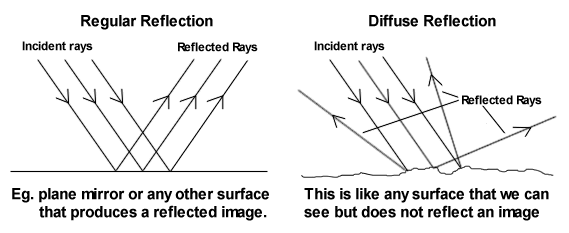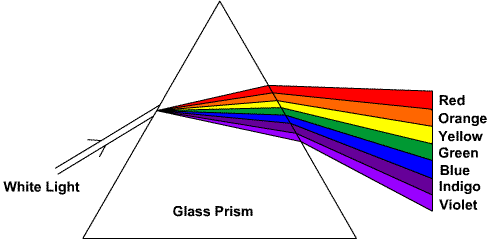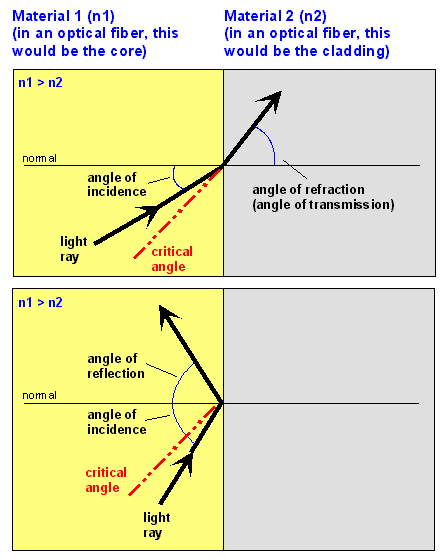Light waves are transverse waves, they travel in straight lines so it is 'rectilinear'. It can be reflected, if not we wouldn't be able to see, because light is constantly reflecting off objects into our eyes.
It can also be refracted, which people like to think of as the light 'bending', as it is changing direction. But keep in mind the light ray is still straight.
Diffraction is for single science, but it's basically about the waves spreading out after passing through a gap. For light, you can only see it diffracting if it passes through a very narrow slit as it has such a small wavelength.
See the animation: http://www.lon-capa.org/~mmp/kap13/cd372.htm
3.15 recall that the angle of incidence equals the angle of reflection
This is the Law of Reflection:

When a light ray strikes a plane mirror, it reflects off it.
And the angle of incidence=the angle of reflection.
We draw a 'normal', which is an imaginary line perpendicular (at right angles to) to the plane mirror. The angle between the light ray and the normal is the angle of incidence, and the angle between the reflected ray and the normal is the angle of reflection. If it is a plane mirror these angles would be the same.
 |
| If it's not a flat surface like a plane mirror, the law does not apply. |
3.16 construct ray diagrams to illustrate the formation of a virtual image in a plane mirror

- First you draw your object, a short straight line will do to keep things simple. And you draw a plane mirror in the centre.
- You draw light rays as straight lines from the 2 ends of your line, 2-3 will do.
- Reflect this off the plane mirror in the centre of your page. (Remember the law of reflection, the angle of incidence=the angle of reflection.)
- Then you extend these reflected light rays beyond the plane mirror. Like the above diagram. See how the dotted lines are extended 'into' the mirror?
- Remember you drew lines from both ends of your object? Well where the dotted lines meet behind the mirror will form the 2 ends of the virtual image of your object. Try it!
- Notice that the virtual image is the same size as the object, but is laterally inverted.
you could also try more complicated objects, but the result would be the same:

3.17 describe experiments to investigate the refraction of light, using rectangular blocks,
semicircular blocks and triangular prisms
Place a glass block on a sheet of white paper and draw a line all around it. Using a ray/light box, shine a ray of light from the air into the glass. Mark the incident ray with crosses and where it enters the block, and do the same for the refracted ray. Draw your lines and you would note that the ray of light didn't travel straight through the glass. It was bent, or refracted where it entered the glass and where it left the glass.
Rays of light travelling from air into glass are refracted towards the normal. (less dense to denser material)
Rays of light travelling from glass into air are refracted away from the normal. (denser to less dense material)
The emergent or refracted ray is parallel to the incident ray because the change in angle of the light ray is the same as it enters and leaves the glass.
 |
| Triangular prisms refract white light into its spectrum, violet refracts the most as it has the shortest wavelength. |
Experiment using semicircular block:
About refraction of light, super good to help you understand, it's slow and easy to follow:
3.18 recall and use the relationship between refractive index, angle of incidence and angle
of refraction:
n=sin i/sin r
where n=refractive index
i=angle of incidence
r=angle of refraction
This is about how much the light would be refracted going from air into another substance. The refractive index of most kinds of glass is about 1.5, but for water it is less, 1.33, which means that the light is not bent as much when it enters water-because it is not slowed as much. (Water is denser than air, so when the light enters water it slows down.)
Substance
|
Refractive Index
|
Speed of light (m/s)
|
Air
|
1.0
|
300 000 000
|
Water
|
1.33
|
225 000 000
|
Perspex
|
1.5
|
200 000 000
|
Glass
|
About 1.5
|
200 000 000
|
Diamond
|
2.4
|
120 000 000
|
When light hits a denser material you know that it refracts towards the normal, and it also slows down. Though its velocity decreases, its frequency does not. A constant frequency means that the same number of light waves must pass by in the same amount of time. If velocity decreases, the wavelength must decrease as well to maintain the same frequency.
I'm not so sure how to explain why frequency doesn't change but to change it you'll have to change it from its source. Frequency is a function of the energy level of the photons in light, and changing the medium doesn't change that energy level. The energy level of the photon is determined at the time of its emission and stays constant thereafter.. This is way beyond IGCSE btw so don't bother, it's do with Faraday and Maxwell's equations or smth..
3.19 describe an experiment to determine the refractive index of glass, using a glass block
Shine a ray of light into the glass box and draw the incident ray and the refracted ray. Draw the 2 normals like the above diagram, and measure the angle of incidence and the angle of refraction. Then use n=sin i/sin r to find out the refractive index of glass.
3.20 describe the role of total internal reflection in transmitting information along optical
fibres and in prisms
To understand total internal reflection you must understand what the critical angle is first. This is the angle of incidence in the optically denser medium for which the angle of refraction in the less dense medium is 90°. As seen in the above diagram, the red ray of light is refracted along the edge of the water, if you draw a normal to it, it would be perpendicular, so the angle of refraction is 90°.
Total internal reflection is when all the light is reflected inside the more dense substance.
Total internal reflection only takes place when:
- the rays are travelling in a dense medium towards a less-dense medium
- the angle of incidence in the optically denser medium is greater than the critical angle
Optical fibres are very thin and flexible. The outer cladding has a lower refractive index than the core so the light rays inside the core can be totally internally reflected.
The light rays entering the optical fibre will come out the other end as it experiences total internal reflection (if its angle of incidence is greater than the critical angle of course). So optical fibres can transmit information easily and are now commonly used in telecommunications.
 |
| this may help you understand the optical fibre stuff better, see how if the light ray enters at an angle greater than the critical angle it reflects instead of refracts out? |
Prisms in a periscope:
As the ray of light goes straight through the prism it meets the second surface at an angle of 45°, this is greater than the critical angle of glass which is 42°. So total internal reflection takes place. So the light ray is turned through 90°. This happens again in the second prism and the light ray eventually enters your eye and you can see the object the light ray came from.
3.21 recall the meaning of critical angle c
I explained critical angle earlier to help you understand total internal reflection, but anways, just remember:
This is the angle of incidence in the optically denser medium for which the angle of refraction in the less dense medium is 90°.
3.22 recall and use the relationship between critical angle and refractive index:
sin c = 1/n
3.26 recall that sound waves are longitudinal waves which can be reflected, refracted and
diffracted
all you have to do is 'recall'... so just know it.
3.27 recall that the frequency range for human hearing is 20 Hz –– 20 000 Hz
just remember this. Above 20 000 Hz is ultrasound.
3.28 describe how to measure the speed of sound in air
Here's one from my textbook:
Stand a measured 50 metres from a large wall. Clap and listen to the echo. Then try to clap in an even rhythm of clap-echo-clap-echo-clap... while a friend times 100 of your claps with a stopwatch.
During the time from one clap to the next clap, the sound would have time to go to the wall and back, twice-that is a distance of 200 metres.
In the time of 100 claps, the sound would travel 200 x 100 = 20 000 metres.
s=d/t
speed=distance travelled/time taken=20 000 metres/time in seconds
I mean if they ever ask you a question about finding speed, just recall s=d/t.



really helpful! thanks :)
ReplyDeleteGREAT BLOG!!!!!
ReplyDeletecan u add stuff on section 6
ReplyDeletemichelle do oyu plan to get 100%? *____* CAN I HAVE YOUR BRAIN PLS???????
ReplyDeletecan you include triple as well?
ReplyDeleteSorry i've finished IGCSEs and I'm doing IB now; and I'm taking HL Chem and Bio, not physics! So I'm not really updating these blogs anymore. :S Sorry, hope what's posted still helps though!! :)
DeleteI dont know how you had the heart and time to all of this but i am so so so so so glad that you did! I LOVE YOU! :* you have a huge heart!
ReplyDeletewhat about resonance tubes ?
ReplyDeleteI am so grateful for this...it has helped me a lot..thank you very much....May God bless you :)
ReplyDeleteYoure great! Thank you so much--I owe you alot!! <3
ReplyDeleteyour an absolute legend...
ReplyDeletethanks
ReplyDeletereally helped
:-)
this is amazing. i have really struggled to find materials for my course and this is perfect. it has really saved my revision. thank you so much, i don't think you realise how much you have helped people.
ReplyDeletethank you xxxxx
Physics exam is tomorrow and its because of this site i can say that that im ready to take it :) thank you so much
ReplyDeleteTwo words : THANK YOU. :D
ReplyDeleteOMG! these stuff helped me alot... :)
ReplyDeleteI really owe u! but dont knw wht to do xD
anyway thnk u aloooooot!
Love, a gal.. :))xx
thank u again
Hey MIchelle.. You are a life saver.
ReplyDeleteAwesome blog! :D
So many regards from a student :)
OMG YOU'RE SO CUTE <3 THANK YOU ALOT YOU HELPED MEE SOO MUCH
ReplyDeleteMy assessment is tomorrow and I have lost my notes......i wish these will be enough to study...but any way thanks your great :D
ReplyDeleteRead Light Class 10 | SEE Notes
ReplyDeleteThis comment has been removed by the author.
ReplyDeletellll
ReplyDeletecorona
ReplyDelete